
The Qing dynasty, officially the Great Qing, was a Manchu-led imperial dynasty of China and the last imperial dynasty in Chinese history. The dynasty, proclaimed in Shenyang in 1636, seized control of Beijing in 1644, often considered the start of the dynasty's rule. The dynasty lasted until the Xinhai Revolution of October 1911 led to the abdication of the last emperor, February 12, 1912. In Chinese historiography, the Qing dynasty was preceded by the Ming dynasty and succeeded by the Republic of China. The multi-ethnic Qing dynasty assembled the territorial base for modern China. It was the largest imperial dynasty in the history of China and in 1790 the fourth-largest empire in world history in terms of territorial size. With over 426 million citizens in 1907, it was the most populous country in the world at the time.

China proper, also called Inner China, are terms used primarily in the West in reference to the traditional "core" regions of China centered in the southeast. The term was first used by Westerners during the Manchu-led Qing dynasty to describe the distinction between the historical "Han lands" (漢地)—i.e. regions long dominated by the majority Han population—and the "frontier" regions of China where more non-Han ethnic groups and new foreign immigrants reside, sometimes known as "Outer China". There is no fixed extent for China proper, as many administrative, cultural, and linguistic shifts have occurred in Chinese history. One definition refers to the original area of Chinese civilization, the Central Plain ; another to the Eighteen Provinces of the Qing dynasty. There was no direct translation for "China proper" in the Chinese language at the time due to differences in terminology used by the Qing to refer to the regions. Even to today, the expression is controversial among scholars, particularly in mainland China, due to issues pertaining to contemporary territorial claim and ethnic politics.
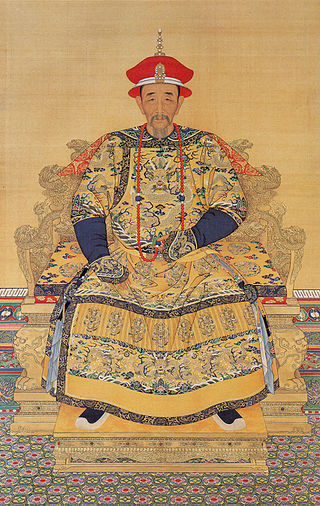
The Kangxi Emperor, also known by his temple name Emperor Shengzu of Qing, personal name Xuanye, was the fourth emperor of the Qing dynasty, and the second Qing emperor to rule over China proper. His reign of 61 years makes him the longest-reigning emperor in Chinese history and one of the longest-reigning rulers in history. He is considered one of China's greatest emperors.
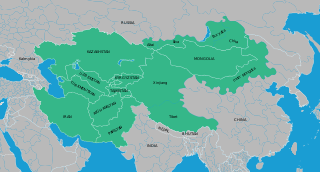
Inner Asia refers to the northern and landlocked regions spanning North, Central and East Asia. It includes parts of western and northeast China, as well as southern Siberia. The area overlaps with some definitions of "Central Asia", mostly the historical ones, but certain regions that are often included in Inner Asia, such as Manchuria, are not a part of Central Asia by any of its definitions. Inner Asia may be regarded as the western and northern "frontier" of China proper and as being bounded by East Asia proper, which consists of China proper, Japan and Korea.

Johann Adam Schall von Bell was a German Jesuit, astronomer and instrument-maker. He spent most of his life as a missionary in China and became an adviser to the Shunzhi Emperor of the Qing dynasty.

Astronomy in China has a long history stretching from the Shang dynasty, being refined over a period of more than 3,000 years. The ancient Chinese people have identified stars from 1300 BCE, as Chinese star names later categorized in the twenty-eight mansions have been found on oracle bones unearthed at Anyang, dating back to the mid-Shang dynasty. The core of the "mansion" system also took shape around this period, by the time of King Wu Ding.

Mathematics emerged independently in China by the 11th century BCE. The Chinese independently developed a real number system that includes significantly large and negative numbers, more than one numeral system, algebra, geometry, number theory and trigonometry.
Mādhava of Sangamagrāma (Mādhavan) was an Indian mathematician and astronomer who is considered to be the founder of the Kerala school of astronomy and mathematics in the Late Middle Ages. Madhava made pioneering contributions to the study of infinite series, calculus, trigonometry, geometry and algebra. He was the first to use infinite series approximations for a range of trigonometric functions, which has been called the "decisive step onward from the finite procedures of ancient mathematics to treat their limit-passage to infinity".
The Lifan Yuan was an agency in the government of the Qing dynasty of China which administered the empire's Inner Asian territories such as Mongolia and oversaw the appointments of Ambans in Tibet. Until the 1860s, it was also responsible for the Qing's relations with the Russian Empire.

The Three Pillars of Chinese Catholicism refer to three Chinese converts to Christianity, during the 16th and 17th century Jesuit China missions:

The Kumul Khanate was a semi-autonomous feudal Turco-Mongol khanate within the Qing dynasty and then the Republic of China until it was abolished by Xinjiang governor Jin Shuren in 1930. The khanate was located in present-day Hami prefecture of Xinjiang.

The history of the missions of the Jesuits in China is part of the history of relations between China and the Western world. The missionary efforts and other work of the Society of Jesus, or Jesuits, between the 16th and 17th century played a significant role in continuing the transmission of knowledge, science, and culture between China and the West, and influenced Christian culture in Chinese society today.

Chinese Tartary is an archaic geographical term referring to the regions of Manchuria, Mongolia, Xinjiang, and Tibet under the rule of the Qing dynasty of China. The geographical extent of Chinese Tartary largely corresponds with that of the "Feudatory Regions", as defined by the Qing court. The term "Tartar" was used by Europeans to refer to ethnicities living in northern, northeastern, and western China, including the Mongols, Manchus, Tibetans, and Central Asians. Some definitions include the Japanese. The regions are now more commonly referred to by scholars as Inner Asia.

The Dzungar–Qing Wars were a decades-long series of conflicts that pitted the Dzungar Khanate against the Qing dynasty and its Mongol vassals. Fighting took place over a wide swath of Inner Asia, from present-day central and eastern Mongolia to Tibet, Qinghai, and Xinjiang regions of present-day China. Qing victories ultimately led to the incorporation of Outer Mongolia, Tibet and Xinjiang into the Qing Empire that was to last until the fall of the dynasty in 1911–1912, and the genocide of much of the Dzungar population in the conquered areas.
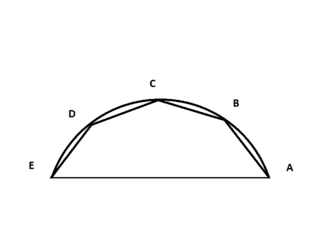
Ming Antu's infinite series expansion of trigonometric functions. Ming Antu, a court mathematician of the Qing dynasty did extensive work on the infinite series expansion of trigonometric functions in his masterpiece Geyuan Milü Jiefa (Quick Method of Dissecting the Circle and Determination of The Precise Ratio of the Circle). Ming Antu built geometrical models based on a major arc of a circle and the nth dissection of the major arc. In Fig 1, AE is the major chord of arc ABCDE, and AB, BC, CD, DE are its nth equal segments. If chord AE = y, chord AB = BC = CD = DE = x, the task was to find chord y as the infinite series expansion of chord x. He studied the cases of n = 2, 3, 4, 5, 10, 100, 1000 and 10000 in great detail in volumes 3 and 4 of Geyuan Milü Jiefa.
The New Qing History is a historiographical school that gained prominence in the United States in the mid-1990s by offering a major revision of history of the Manchu-led Qing dynasty of China.
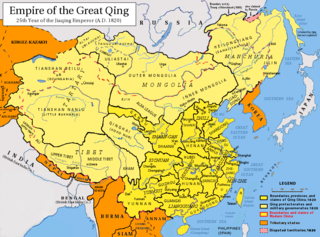
The Qing dynasty in Inner Asia was the expansion of the Qing dynasty's realm in Inner Asia in the 17th and the 18th century AD, including both Inner Mongolia and Outer Mongolia, both Manchuria and Outer Manchuria, Tibet, Qinghai and Xinjiang.

The Later Jin, officially known as Jin or the Great Jin, was a Jurchen-led royal dynasty of China in Manchuria and the precursor to the Qing dynasty. Established in 1616 by the Jianzhou Jurchen chieftain Nurhaci upon his reunification of the Jurchen tribes, its name was derived from the earlier Jin dynasty founded by the Wanyan clan which had ruled northern China in the 12th and 13th centuries.
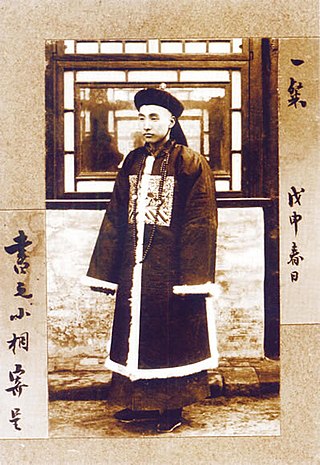
The Qing dynasty (1644–1912) was the last imperial dynasty of China. The early Qing emperors adopted the bureaucratic structures and institutions from the preceding Ming dynasty but split rule between the Han and Manchus with some positions also given to Mongols. Like previous dynasties, the Qing recruited officials via the imperial examination system until the system was abolished in 1905. The Qing divided the positions into civil and military positions, each having nine grades or ranks, each subdivided into a and b categories. Civil appointments ranged from an attendant to the emperor or a grand secretary in the Forbidden City (highest) to being a prefectural tax collector, deputy jail warden, deputy police commissioner, or tax examiner. Military appointments ranged from being a field marshal or chamberlain of the imperial bodyguard to a third class sergeant, corporal or a first or second class private.
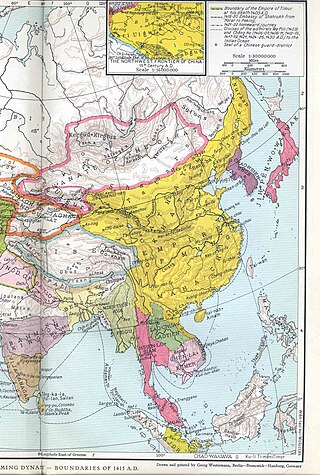
The Ming dynasty in Inner Asia was the expansion of the Ming dynasty's realm and influence in Inner Asia between the 14th and the 16th centuries. The Ming dynasty overthrew and succeeded the Mongol-led Yuan dynasty and sought to avert further incursions by a regime originating from Inner Asia. Wars were fought against the Northern Yuan, which existed as a rump state after the collapse of the Yuan dynasty in 1368, but also against other states in Inner Asia including the Oirat Confederation and Moghulistan. As a result, Ming China at the height incorporated Manchuria, much of the regions of Inner Mongolia and Qinghai, and parts of Xinjiang into its realm, and also had some degree of influence in Tibet especially during the reign of the Yongle Emperor.




















